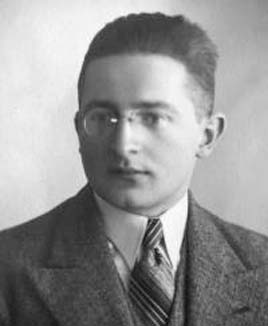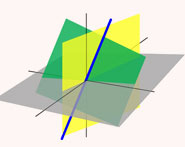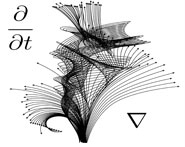


 تاريخ الرياضيات
تاريخ الرياضيات
 الرياضيات في الحضارات المختلفة
الرياضيات في الحضارات المختلفة 
 الرياضيات المتقطعة
الرياضيات المتقطعة
 الجبر
الجبر
 الهندسة
الهندسة 
 المعادلات التفاضلية و التكاملية
المعادلات التفاضلية و التكاملية 
 التحليل
التحليل
 علماء الرياضيات
علماء الرياضيات |
Read More
Date: 9-11-2017
Date: 12-10-2017
Date: 9-11-2017
|
Died: 13 February 1980 in Warsaw, Poland

Marian Rejewski's parents were Józef Rejewski, who was a cigar merchant, and Matylda Thoms. The town of Bydgoszcz, where Rejewski was born and brought up, was in the Prussian partition of Poland and was also known by the German name Bromberg. It was at a German speaking Gymnasium in Bydgoszcz, the Königliches Gymnasium of Bromberg, that Rejewski was educated. He graduated in 1923 and entered the Adam Mickiewicz University of Poznan to study mathematics.
After Rejewski graduated with his first degree in mathematics, he remained at Poznan University to study for his Master's degree. He was awarded that degree on 1 March 1929 for his thesis Theory of double periodic functions of the second and third kind and its applications. He then went to Göttingen University in Germany to enrol in a two-year actuHelvetica statistics course. However, he did not complete the course for, in the summer of 1930 when he had returned home for a break in his studies, he was offered a position as a teaching assistant in mathematics at Poznan University. He accepted the offer and began teaching there.
Now before going to Göttingen, Rejewski had attended a cryptology course which was put on by the Cipher Bureau for the best German speaking mathematics students. After he accepted the teaching position at Poznan University he began to work part-time for the Poznan Branch of the Cipher Bureau. They were interested in decoding intercepted German radio transmissions which were broadcast using a new cipher system. These messages were coded by an Enigma machine, but at this time even this fact was not known to the Poles. However, the Poznan Branch of the Cipher Bureau was disbanded in the summer of 1932 and, on 1 September 1932, Rejewski began to work full-time at the Cipher Bureau in Warsaw. There he was joined by another two young Polish mathematicians, Jerzy Rozycki and Henryk Zygalski.
The team had a commercial Enigma machine which Rejewski was able to study, but it was clear that the messages were being sent by military style Enigma machines which were modified versions of the commercial type. Rejewski explained in [9] how he broke the codes. His introduction to the paper gives an overview (we've made a few changes to the English):-
Cryptology, that is the science of ciphers, has from the very beginning applied some mathematical methods, mainly the elements of probability theory and statistics. Mechanical and electromechanical ciphering devices, introduced to practice in the 1920s, broadened considerably the field of applications of mathematics in cryptology. This is particularly true of the theory of permutations, known for over a hundred years, called formerly the theory of substitutions. Its application by Polish cryptologists in the years 1932 - 33, enabled the German Enigma cipher to be broken, which subsequently exerted a considerable influence on the course of the 1939 - 1945 war operation in the European and African, as well as the Far East, war theatres. The present paper is intended to show, necessarily in great brevity and simplification, some aspects of the Enigma cipher breaking, in particular those which used the theory of permutations. This paper is not a systematic outline of the process of breaking the Enigma cipher, but presents, however, its important part.
On 20 June 1934 Rejewski married Irena Maria Lewandowska; they had two children, Andrzej born in 1936 and Janina born in 1939. During this time, he continued to work at the Cipher Bureau in Warsaw. Although the methods devised by Rejewski allowed many messages encoded by the Enigma machine to be read, in September 1936 the Germans changed the coding procedure to introduce a more secure system. Again Rejewski, with assistance from Rozycki and Zygalski, was able to make good progress with the greater complexity which had been introduced, and by January 1938 they were able to read about three-quarters of the Enigma messages which were passed to them for decoding. However, the Germans added further complexities to the Enigma machine in December 1938, and again the Poles worked on breaking the codes. Rejewski was able to pass his knowledge of decoding the Enigma messages to the British and French at a meeting which took place in July 1939 at Pyry to the south of Warsaw.
After the Germany army invaded Poland on 1 September 1939, it advanced rapidly towards Warsaw. Rejewski, along with others who had worked at the Cipher Bureau in Warsaw, was evacuated to Romania (although his wife and family remained in Poland) before the German troops reached Warsaw. Rejewski, Rozycki and Zygalski managed to avoid being forced into a refugee camp and they reached Bucharest where, after an unsuccessful attempt to get help from the British embassy, they made contact with the French embassy. The three Polish mathematicians were evacuated to Paris which they reached before the end of September. In October they joined a joint French-Polish-Spanish decoding unit at the Château de Vignolles north east of Paris and by the end of the year they were again managing to decode messages sent by the German Enigma machines.
In May 1940 Germany invaded France, and on 14 June German troops entered Paris. France surrendered on 22 June and, two days later, Rejewski and his colleagues were evacuated to Algeria. Germany occupied the north and east of France while the French set up a new government in Vichy under the leadership of Marshal Pétain which saw itself as a partner of Germany. Rejewski and his colleagues returned to this unoccupied Vichy France in September 1940 to work there in secret. To hide his real identity, Rejewski posed as a professor of mathematics from a lycée in Nantes. He worked at the Château des Fouzes near Uzès where a secret intelligence unit was set up. Again Rejewski and his colleagues began decoding German messages but on 9 January 1942 Jerzy Rozycki died when a ship on which he was returning to France after a stay in Algeria was sunk. Later that year, after the Allies invaded North Africa, the German troops occupied Vichy France. The secret intelligence unit in the Château des Fouzes was in severe danger and it was evacuated on 9 November 1942, three days before German soldiers discovered it.
Rejewski and his remaining colleague Zygalski moved around many of the cities of southern France avoiding capture. They eventually decided to attempt to cross the Pyrenees to reach Spain. Despite being robbed by their guide at gun point, they reached Spain, only to be put in prison. At first they were imprisoned at Séo de Urgel where they were held from January to March 1943, then they were moved to a prison in Lerida. On 24 May they were released and sent to Madrid. From there they made their way to Portugal and, after transfer by Royal Navy ship to Gibraltar, they were flown to Britain where they arrived 3 August 1943. Rejewski then joined the Polish Army in Britain and remained there for the rest of the war, again working on decoding. Had the British authorities had a greater understanding of Rejewski's abilities he would surely have been sent to Bletchley Park to assist the decoding operations being carried out there; sadly this opportunity was missed.
On 21 November 1946 Rejewski was demobbed and returned to Poland to be reunited with his family. They were living with their parents in Bydgoszcz and so, following his return, Rejewski chose not to return to his position as a mathematician at Poznan University (although it was still open to him) and took a job as a supervisor of sales at Polish Cable. Rejewski's family suffered a tragic loss shortly after his return when his eleven year old son died from polio. Their life was, over many years, made extremely difficult by enquiries carried out by the Polish Security Service. Rather remarkably, however, the Security Service never discovered his role in deciphering Enigma code. Despite not finding this out, nevertheless they demanded that he be dismissed from his position which happened in 1950. He then held a number of positions before becoming a bookkeeper at the Provincial Union of Labour Cooperatives in 1954. He held this position until he retired in 1967.
Up to the time of his retirement Rejewski had maintained complete secrecy about his work in cryptology. However he writes in [9]:-
It should be mentioned that the present paper is the first publication on the mathematical background on the Enigma cipher breaking. There exist, however, several reports related to this topic by the same author: one - written in 1942 - can be found in the General Wladyslaw Sikorski Historical Institute in London, and the other - written in 1967 - is deposited in the Military Historical Institute in Warsaw.
Rejewski and his family moved to Warsaw in 1969 and the full story of his involvement with the Enigma cipher breaking emerged in 1973. This led to him becoming famous through newspaper articles, radio and television programmes. He himself wrote a number of technical articles, see [9], [10], and [11]. He died at his home in Warsaw following a heart attack and was buried with full military honours.
Books:
Articles:



|
|
|
|
دخلت غرفة فنسيت ماذا تريد من داخلها.. خبير يفسر الحالة
|
|
|
|
|
|
|
ثورة طبية.. ابتكار أصغر جهاز لتنظيم ضربات القلب في العالم
|
|
|
|
|
|
|
سماحة السيد الصافي يؤكد ضرورة تعريف المجتمعات بأهمية مبادئ أهل البيت (عليهم السلام) في إيجاد حلول للمشاكل الاجتماعية
|
|
|